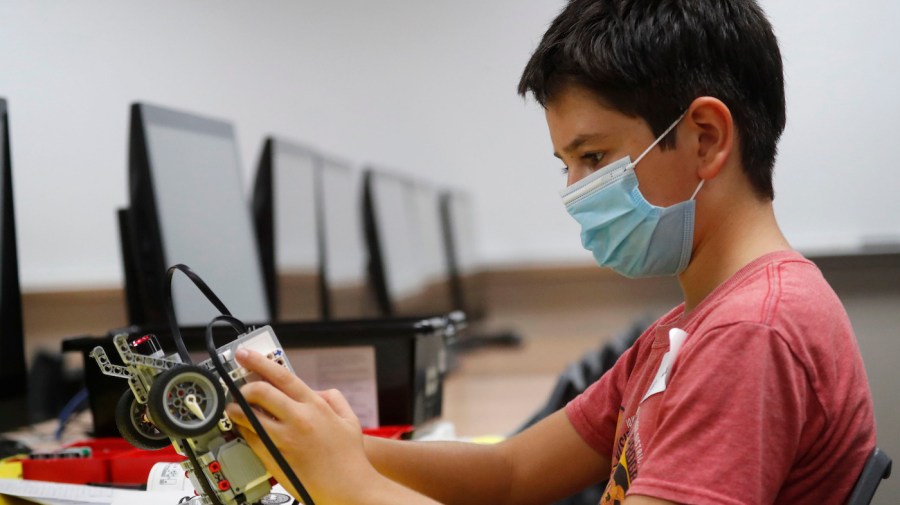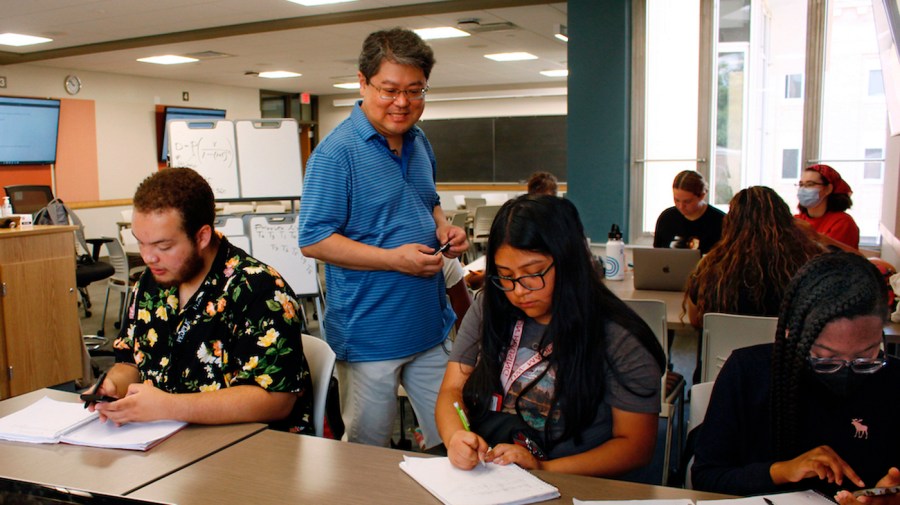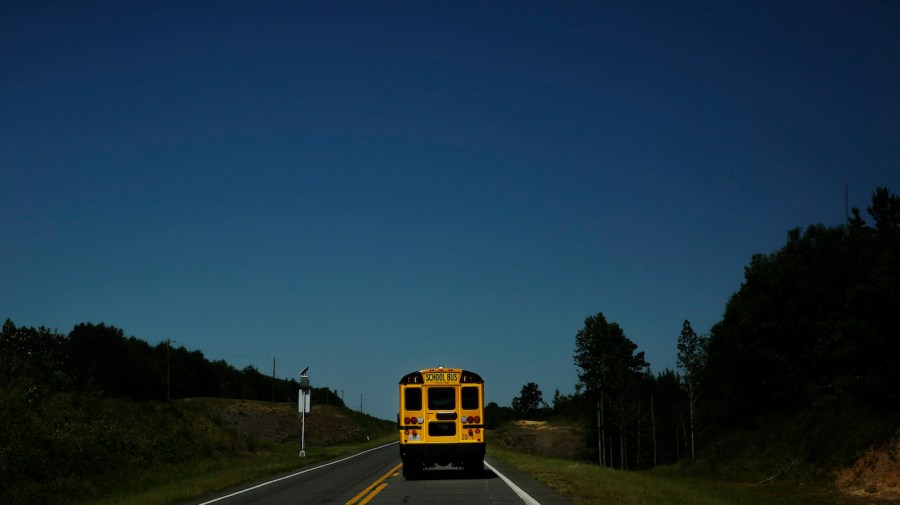The secret summer lives of American schools

Every summer, America’s tens of thousands of public schools undergo a transformation as regular but radical as any in nature. Emptied of their students and staff, many hibernate. But others transform.
Public school buildings take up around 2 million acres of land, according to the nonprofit Trust for Public Land, often in the middle of communities where they are most accessible. And in the summertime lull, they play host to everything from water parks to church services.
“This year, we’re going to have a Minecraft coding camp in our building,” Crystal Thorpe, the principal of Fishers Junior High School in Fishers, Ind., told The Hill, adding that her campus will also be used for basketball, volleyball and orchestra camps.
Camps and summer school classes are indeed both highly popular options. Research group Think Impact found more than 3.3 million students went to summer school in 2020 to either retake classes or take care of required courses.

Sixth-grader Salih Tas works on building a robot during a STEM summer camp at Wylie High School on July 14, 2020, in Wylie, Texas. (AP Photo/LM Otero)
But other schools don’t just open up to students.
Leesburg High School in central Florida, for one, rents out two areas on its grounds for church services on Sunday.
Principal Mike Randolph says he’s aware of the church-and-state concerns such an arrangement might raise, but that “the community is really behind it.”
“It’s something that I’ve always done as a principal is partner with newer and younger churches. Just because as they’re starting up, it’s really expensive to build a building. So instead of focusing their funds on building the building, it’s nice to allow them to rent out our space,” Randolph said, adding the church also does a lot of work for the school and calling the partnership a “blessing.”
Leesburg High additionally partners with the Fellowship of Christian Athletes, which runs a track program there over the summer.
And Randolph said the school also hosts multiple camps including a cheerleading camp and a youth camp led by the Leesburg football team.
Making the most of public spaces
Some schools have thought even bigger as they partnered with Trust for Public Land, a D.C.-based organization that runs a program called Community Schoolyard Projects where it works with schools on designs and fundraising to alter their outdoor spaces to be used by the whole community.
Danielle Denk, community schoolyard initiative director for the group, said one New Jersey school opted to create a public water park.
“Of course, during the school day, you can’t have a water park outside because it would just be a mess. But during the summer it’s a wonderful cooling destination,” Denk said.
At another school in New York City, Trust for Public Land asked the girls what they want in their schoolyard, and the students said they wanted a basketball court the boys wouldn’t take over. The girls asked for two of the basketball courts that were getting installed to be pink and purple so they can use them without more masculine interference.
Trust for Public Land most often works in urban areas but has recently done more projects in rural communities and is now partnering with the Bureau of Indian Education on transforming the schoolyards of tribal schools.
“What’s so interesting is that the school in a rural setting is often the only place where the community comes together in a kind of an intimate civic capacity. It may be the only playground that those kids in that rural community have access to and might be the only place where Fourth of July celebrations happen,” Denk said.
Summers, of course, aren’t all fun and games, as many students need to use the break to retake classes or prepare for the next phase of their education.

Instructor Oh Hoon Kwon speaks to students during a math class that was part of an intense six-week summer bridge program for students of color and first-generation students at the University of Wisconsin, in Madison, on July 27, 2022. (AP Photo/Carrie Antlfinger)
“We’ll have some freshmen transition programs to help students transition between eighth and ninth grade,” said Robert Covert, the principal of Hereford High School in Maryland. “We’ll have other targeted programs like helping students transition to AP classes for the first time.”
Even more important is keeping children fed.
No Kid Hungry estimates around 9 million U.S. children are food insecure and rely on the free breakfast and lunch available during the school year. But only a fraction of that number have a summer meal program available to them.
“You know, I’m going to love smelling the smell of fresh diesel as the buses pull away. But I’m also going to be without our students … for 12 weeks,” Leesburg High’s Randolph said. “And that makes me nervous as to what they’re going to get involved — are they’re going to eat two meals? You know, we provide them two meals a day.”
While still uncommon, some schools are becoming more proactive about offering summer meals.
“Our school has been designated as the place, and so we’re going to offer lunch to any kid in our district up to 18 [years old]. Anyone in our district can come and have lunch,” Thorpe of Fishers Junior High said.

A bus full of meals drives down a Georgia road as Chattahoochee County schools provide meals for their students for the last time before summer break on May 7, 2020, in Cusseta. (AP Photo/Brynn Anderson)
The value of keeping schools open over the summer in some form and giving opportunities to children and families goes beyond just keeping students busy and out of trouble.
“We’ve seen many positive outcomes from mental health improvements to academic attendance to participation in activities to better relations with teachers and the parents — certainly better bridges between the school and the community — that we’re now looking to establish a standard practice,” Denk said.
Organizations such as the American Psychological Association have been sounding the alarm on the long-term effects the coronavirus pandemic has had on children. Mental health emergency room visits have risen, test scores have fallen and teachers say increases in behavioral problems have yet to abate.
Creating a place over the summer where kids can develop relationships “is just huge for students,” said Jodi Grant, the executive director of Afterschool Alliance.
“It is meeting a real important need in rural communities,” Grant said.
“For schools that aren’t doing this, they should figure out why, even if it’s a school that doesn’t have air conditioning. They still probably have some room, some facilities, some fields that can absolutely be used to do summer learning programs,” she added.
‘Ready for the next year’
Converting school grounds and offering those summer activities is no easy feat, and Denk said often local residents need to be convinced.
“A question that comes up during participatory design: ‘Is it just gonna just invite people who might not be using the park in the right way into the space? Is there going to be litter? Is there going to be trash? Is there going to be violence in the schoolyard if we open it up to the community?’” she said.
But she added the projects have been “robustly successful in some of the communities where you wouldn’t expect that,” including places where drug and gang violence are high.
Meanwhile, under the hood, summer obviously offers the best opportunity for less glamorous but highly essential on-campus tasks such as construction and deep cleaning.
Covert, the principal from Maryland, said his building service crew stays “really busy.”
“They do a great job of getting the building ready for the next year, and that involves taking all the furniture out of the classrooms and scrubbing the floors and waxing the floors and, you know, doing all the cleaning like cleaning the blinds and the lights,” Covert said.
The next school year is always just a summer away.
Copyright 2023 Nexstar Media Inc. All rights reserved. This material may not be published, broadcast, rewritten, or redistributed.

